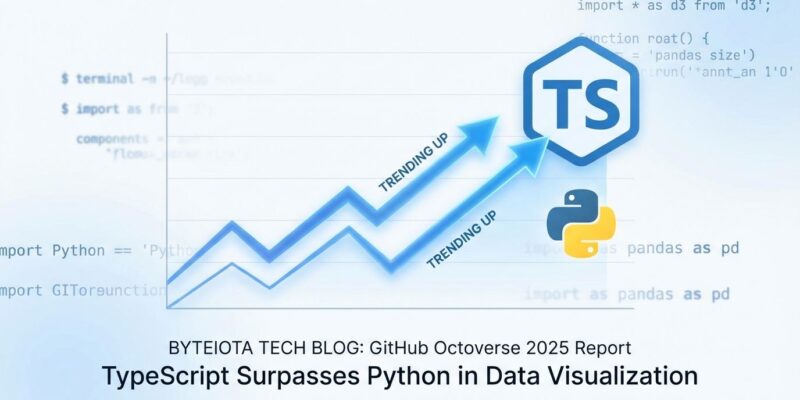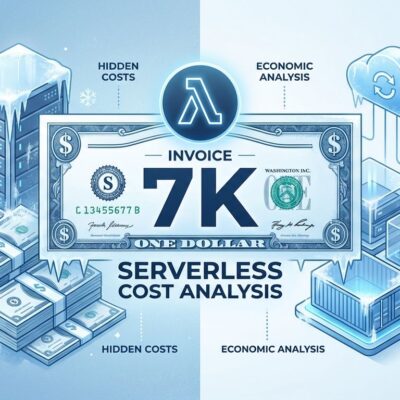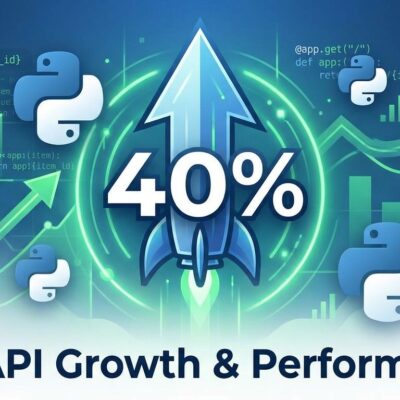
TypeScript overtook Python as GitHub’s #1 language in August 2025, ending Python’s years-long dominance with 2.636 million monthly contributors—a 66% year-over-year surge that represents the biggest language shift in over a decade. But this isn’t a zero-sum battle. Python grew 48% simultaneously, adding 850,000 contributors. The real story isn’t “TypeScript wins, Python loses.” It’s that AI coding tools are fundamentally changing how developers choose languages, favoring type safety over expressiveness, and pushing enterprises toward hybrid architectures where both languages thrive in their lanes.
The Numbers Behind the Milestone
GitHub’s Octoverse 2025 report, covering September 2024 through August 2025, documents the shift in stark numbers. TypeScript finished with 2.636 million monthly contributors, up 1.05 million year-over-year—a 66.6% growth rate. Python clocked in at 2.6 million contributors, adding 850,000 developers (+48%). TypeScript overtook Python by approximately 42,000 contributors, but the margin matters less than the trajectory.
This is what GitHub officially called “the most significant language shift in over a decade.” Both languages are in explosive growth phases. TypeScript repos grew 78.1% to 5.39 million. Python repos expanded 53.4% to 9.26 million. Python still dominates AI and machine learning with 582,000 AI-tagged repositories. GitHub’s total developer base hit 180 million, with 36 million new accounts in 2025 alone—one new developer every second.
The data doesn’t show replacement. It shows specialization.
Why AI Coding Tools Favor TypeScript
Idan Gazit, head of GitHub Next, explained the mechanism driving the shift: “If an AI tool is going to generate code for me, I want a fast way to know whether that code is correct. Explicit types give me that safety net.”
Type systems reduce what Gazit calls “hallucination surface area.” AI models get explicit constraints to reason within during code generation. They perform measurably better on languages with robust type information. GitHub’s analysis of the AI feedback loop found that TypeScript suggestions usually type-check before execution, while Python errors surface at runtime—after the code ships.
That’s the production difference. When 80% of new GitHub developers use Copilot within their first week, and 1.1 million public repositories already use LLM SDKs, AI tooling isn’t an optional feature. It’s infrastructure. Enterprises deploying AI-generated code demand compile-time safety, not runtime surprises.
AI isn’t optimizing for type safety. Developers are optimizing languages for AI. The second-order effect matters more: junior developers now ship code faster than senior engineers can review it. Type checking becomes the first line of defense when human validation can’t keep pace with AI-assisted velocity.
The Hybrid Stack Emerges as Best Practice
GitHub identified a pattern reshaping enterprise architectures: Python handles the data pipelines, ML training, and AI model work. TypeScript powers the user-facing applications, APIs, and infrastructure that connect everything. Organizations split their stack by language strength combined with AI compatibility.
Python’s position in AI and machine learning remains unchallenged. TensorFlow, PyTorch, scikit-learn—the frameworks that define the space are Python-native. Gazit acknowledged this directly: “Why would I not choose the one that already has the most robust frameworks and libraries?” Python grew 48% because its domain advantage compounds with AI adoption, not despite it.
TypeScript’s advantage is different. It combines the JavaScript ecosystem’s ubiquity with type safety that AI tools leverage effectively. 85% of Node.js developers now prefer TypeScript for enterprise applications. 87% of new JavaScript projects adopted TypeScript in 2025, up from 78% in 2024. Stack Overflow’s 2025 Developer Survey showed Python jumping 7 percentage points year-over-year—proof that AI isn’t killing dynamic languages, it’s redirecting them.
The question isn’t “TypeScript or Python?” It’s “How do you leverage both?” Each language wins where it provides maximum combined value: strong ecosystem plus AI capability. Choose languages for leverage, not loyalty.
Enterprise Adoption Accelerates the Shift
Commercial adoption tells the same story as GitHub’s contributor data. 26,748 verified companies now use TypeScript, according to Landbase. Enterprise adoption grew 400% since 2020. TypeScript developers command a 10-15% salary premium over pure JavaScript roles. Job postings for TypeScript positions increased 50% between 2021 and 2023.
Stack Overflow’s 2023 survey showed 73% developer satisfaction with TypeScript versus 61% for JavaScript. That gap drives migration. InfoWorld’s coverage of the shift highlighted major adopters including Microsoft, Google, and Slack—enterprises that bet billions on their tech stacks.
The commercial momentum reinforces the GitHub data. 78% of professional JavaScript developers now use TypeScript in at least part of their projects. When enterprises pay a salary premium for a technology and developers report higher satisfaction, the trend isn’t hype. It’s structural realignment.
What This Means for Developers
Polyglot skills are becoming table stakes. TypeScript is increasingly essential for web and application development. Python remains critical for AI, data science, and backend services. The developers winning in 2025 don’t pick sides—they optimize for AI-assisted workflows across both languages.
Type safety reduces iteration cycles when working with AI coding tools. Errors caught at compile-time mean fewer debugging sessions and faster shipping. But that doesn’t make dynamic languages obsolete. It makes them specialized.
Gazit pointed to the future: “If any language can target Wasm and run everywhere, that removes one key consideration when picking your stack.” WebAssembly as a universal compilation target shifts the equation. Developers write in their preferred language, AI generates code in that language, everything compiles to Wasm for universal deployment. Language choice becomes about developer experience and AI compatibility, not runtime constraints.
The counterintuitive insight from Octoverse 2025: Bash saw a 206% year-over-year surge in AI-generated projects. AI removes pain barriers, not just productivity barriers. Developers now use “duct tape” languages they’d normally avoid because AI handles the drudgery. This isn’t about writing elegant code. It’s about getting things done.
The Takeaway
TypeScript’s rise to #1 on GitHub represents more than a popularity shift. It signals that AI coding tools are rewriting the criteria for language selection. Type safety moved from a correctness feature to an AI compatibility requirement. Python’s simultaneous 48% growth proves dynamic languages aren’t dying—they’re specializing into domains where their ecosystem advantages outweigh type system trade-offs.
Enterprises are adopting hybrid architectures by design, not accident. The stack that wins combines Python’s data and ML dominance with TypeScript’s application layer safety and AI compatibility. The future belongs to developers who master both, optimize for AI-assisted workflows, and choose languages for leverage rather than tribal loyalty.
The GitHub data is clear. Both TypeScript and Python are winning. The question isn’t which language survives. It’s how well you leverage the strengths of each.











